
(Click title to go directly to the review)
This week’s missing podcast: THE AGE OF DOUCHE!
THE PHANTOM #1
RASPUTIN #1
GROO VS CONAN #4
Advance Review: DJANGO/ZORRO #1
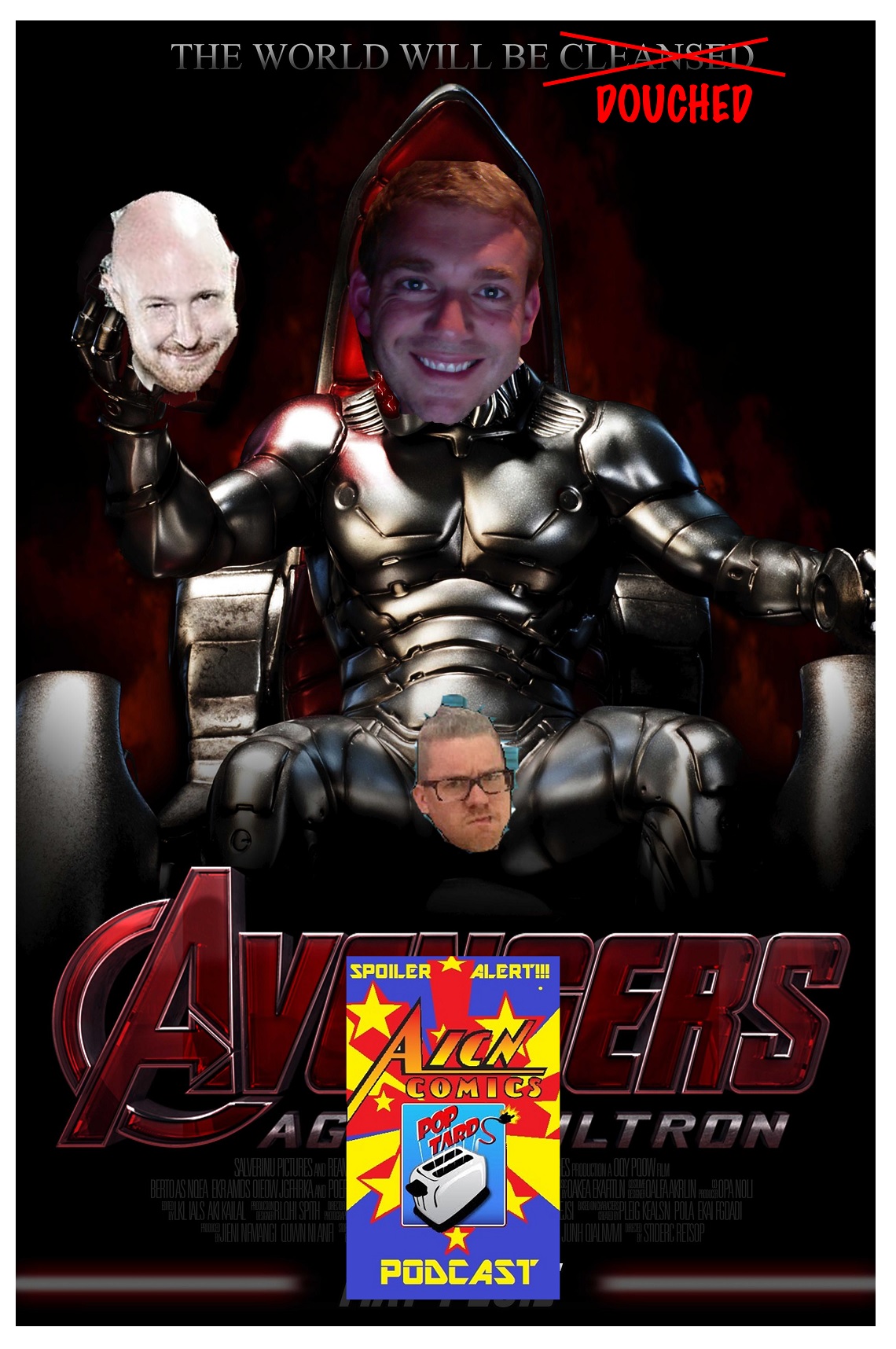 Ambush Bug here. This week, JD pulled some muscles in his back, I got kicked in the face at work, and Matt is still MIA, so Optimous Douche took advantage of the situation and hijacked the podcast. Here’s the mini podcast that transpired focusing on DARK GODS #1 (by Justin Jordan & German Erramouspe from Avatar Press), SOUTHERN BASTARDS #4 (by Jason Aaron & Jason Latour from Image Comics), RASPUTIN #1 (by Alex Grecian & Riley Rossmo from Image Comics), and FUTURES END #27 (by Brian Azzarello & Everyone at DC Comics).
Ambush Bug here. This week, JD pulled some muscles in his back, I got kicked in the face at work, and Matt is still MIA, so Optimous Douche took advantage of the situation and hijacked the podcast. Here’s the mini podcast that transpired focusing on DARK GODS #1 (by Justin Jordan & German Erramouspe from Avatar Press), SOUTHERN BASTARDS #4 (by Jason Aaron & Jason Latour from Image Comics), RASPUTIN #1 (by Alex Grecian & Riley Rossmo from Image Comics), and FUTURES END #27 (by Brian Azzarello & Everyone at DC Comics).Be afraid, be very afraid and click here to listen to the Podcast!
And be on the lookout for AICN HORROR’s new podcast CANNIBAL HORRORCAST every other Thursday!
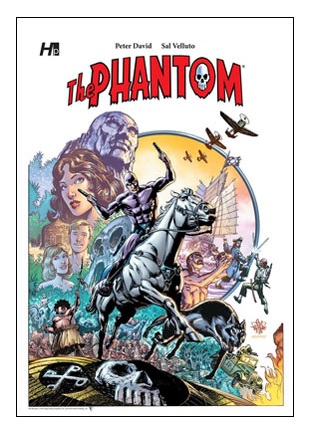
THE PHANTOM #1
Writer: Peter DavidArtist: Sal Velluto
Publisher: Hermes Press
Reviewer: Masked Man
Hermes Press, the company that give us the Buck Rogers mini-series by Howard Chaykin last year, is back with another revival of a classic comicstrip hero, The Phantom, which is a little interesting, because Dynamite Entertainment (the current king of classic characters) just announced their return to The Phantom (scratch head). If memory serves me right, Dynamite bumped heads with Moonstone Books over The Phantom's comic book rights when they first got 'em too. Well, something to keep the lawyers busy, I guess. Either way, here is what I assume to be the start of another four issues miniseries like their Buck Rogers series.
Off the bat you gotta notice that the writer here is fanfav Peter David, most famous for his run on THE INCREDIBLE HULK and a ton of other projects. But I have to say what impressed me the most with this first issue is the Italian artist Sal Velluto. Velluto has been around the US market for a while now, drawing MARC SPECTOR: MOONKNIGHT, JUSTICE LEAGUE TASK FORCE and BLACK PANTHER (among others), yet he has been what I always considered an average comic book artist--a guy who gets the job done well, but not much else. Well not anymore, because this is the best work I've ever seen him do. This is work worthy of George Perez, and reminds me of the late great Don Newton (anyone who doesn't know Don, seriously Google (or Bing) his work now). He just has more control over his work than I've ever seen. Robust comic figures with a nice illustrative style. From the pirates to Devil, Hero, Diana and the Ghost Who Walks himself, everything looks great. His storytelling and layouts are interesting and well done, and he has a great eye for detail in the backgrounds. For such a small company, Hermes Press is mighty lucky to score such a great-looking book.
Getting back to Peter David, while nothing really jumps out as amazing in this first issue, it's an entertaining and well-written first issue. For those who came in late (aka new readers), he gives us the secret origin of The Phantom, sets up his world and then jumps off into an adventure featuring pirates, a city of gold and a supernatural being who maybe a friend or foe. In a nutshell, David knows how to write a first issue, not a boring set-up issue. Everything is so direct and well put together, I can only see the story getting better from here.
Now as a fairly long time fan of The Phantom (I don't own many issues or strips, but I am well read on the character’s history) I couldn't help feel the hand of Simon Wincer, or perhaps I should say Billy Zane, as the tone and dialogue of this issue reminded me very much of that underappreciated THE PHANTOM movie from 1996. In my mind’s eye I could see Billy Zane portraying The Phantom here in this book, as if David was trying to fit this series in that world--although Guran looks like his typical African self, as opposed to the Indian boy who played him in the movie.
Based on this first issue, I'd say any adventure fan is in for a treat with this miniseries. Hermes Press' THE PHANTOM has the right tone, the right script and better artwork than it has any right to. Color me one happy Phantom fan.

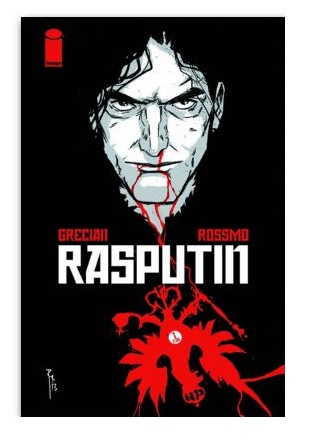
RASPUTIN #1
Writer: Alex GrecianArtist: Riley Rossmo
Publisher: Image Comics
Reviewer: Humphrey Lee
I like to consider myself a history person, except that I suck at it. My bloodthirsty vampire-like thirst for knowledge – both fictional and non – leaves me always wanting to study these periods of humanity developing and what fueled them. Unfortunately, the subject matter is one of those things that falls to the wayside of a life outside of writing reviews that’s tiring and time-consuming, so I typically fail at reading up on anything that doesn’t hit a time frame between the U.S. Civil War up through the New Deal, which is my favorite era to read about. This is why I always eat up (well-written, of course) historical fiction: because it tickles that aspect of my brain that sort of knows things and really, really wants to know more things, but usually settles on escapist material more than fact-filled pieces just so it doesn’t collapse inward on itself like a dying star, given my typical week. The goal is to be entertained while occasionally learning something, but I’m not exactly a stickler for finding myself with a new arsenal of know-it-all anecdotes as long as the story being told captures the zeitgeist of the era it is covering. Bringing this all around to RASPUTIN here, I’m still not exactly sure what the hell we’re getting after this debut, but it sure as hell is intriguing.
To harp a little more on my ignorance, here’s essentially what I know about the Mad Monk, besides him having that moniker: he pissed off pretty much everyone, he was a Hellboy villain, and that the Oni Graphic Novel PETROGRAD was another great piece of Rasputin fiction. Regardless, Grigori Efimovich Rasputin has touched our popular culture enough in works like this to understand the basics of Rasputin being a political figure that was Wile E. Coyote’d to death, and thereby any material with him as the focal point is probably going to be some dark shit. RASPUTIN by Alex Grecian and Riley Rossmo is no exception, but also handles the character with a shocking bit of whimsy that was unexpected. Then again, this whole premiere was a big bag of unexpected.
What was unexpected about it, for me at least, is that I more or less made an assumption that this was going to be in that vein of the aforementioned PETROGRAD, where this was a take on the rise and fall and the larger than life stature of Rasputin in a historical context. I came to assume this A) because I tend to just order books based off creative team and really did not read up on this book outside of the people and publisher involved and B) Alex Grecian’s main body of work the past few years has been his “Scotland Yard” series of books that are very much that zeitgeist type of story for Victorian England. I just blindly assumed this would be the approach to RASPUTIN, but that assumption all goes out the window about two-thirds of the way through this issue when Raspy is using some mystical energies to bring back to life the big fucking grizzly bear that murder-slapped his shitbag father to death and died in the process. Yeah.
So I’m back to being confused as to the general direction of RASPUTIN, but I also do not care because of some fantastic execution. Grecian and Rossmo take that general level of knowledge and just run with it to do whatever the hell they want. We open this issue with Rasputin on the eve of that fateful night his co-conspirators decided to get rid of the man by pulling forms of murder out of a hat and just pulling out all the stops, and it immediately just transports us to a younger time for the Mad one: a time where a young Rasputin was abused by a father who did more than abuse his mother, and where the boy did not hesitate to use out of the goddamn blue magic powers to bring that animal back to life after murder-punching back to the living world. It’s unexpected, it makes the issue read quickly because it’s very visual heavy, and it’s a great mechanism for grounding the book and yet letting the reader know this isn’t just going to be somewhat twisted historical fiction, but a tale about a historical figure with some extra mojo infused and that may or may not have some accuracies within its pages. And it’s a great introduction into the tone and attitude of the titular character and the book he’s in as it’s a cold, hard open to let you know right where you stand with this cold, hard man.
Unfortunately, that is the brunt of the book and it kind of raises a shitton of additional “what is this book going to be about” questions while giving us a solid bit of answers to those same questions in the essence of things. There will be mystical forces and dark arts in play; that is a lock now. To what end, though? No bloody clue. And there’s obviously no way to tell how much of a super-charged biography this will become, so all that matters here is what the ride through handles like, and in this brief glimpse it runs really smoothly. Rossmo is a world-class visual storyteller with an eclectic yet wildly expressive style that you can’t help but love, and it’s a fantastic world builder for telling this particular tale of Rasputin’s shattered youth. The fact that I just typed “Rasputin’s shattered youth” shows that Grecian can and probably will go anywhere, playing up both the man and the myth while turning it into his own legend.
And this excites me.
Yeah, it is probably off the table that I’m going to be learning many factual bits other than some names of some real people Rasputin conspired with/against over the years and whatnot, but it doesn’t matter. The mad energy of that time and place in history is present in these pages, and it’s being channeled through the whims of a really talented creative crew and publishing house in their own rendition of this larger than life figure. If that is the case, so be it--I’ll go get me some of that sweet, sweet non-fiction if I feel like I need something more informational. Right here, right now though, I’m just going to take the good with the Mad and let some creative folks entertain me and, if I’m lucky, educate my ignorant ass.
Humphrey Lee has been an avid comic book reader going on fifteen years now and a contributor to Ain't It Cool comics for quite a few as well. In fact, reading comics is about all he does in his free time and where all the money from his day job wages goes to - funding his comic book habit so he can talk about them to you, our loyal readers (lucky you). He's a bit of a social networking whore, so you can find him all over the Interwebs on sites like Twitter, The MySpaces, Facebookand a blog where he also mostly talks about comics with his free time because he hasn't the slightest semblance of a life. Sad but true, and he gladly encourages you to add, read, and comment as you will.
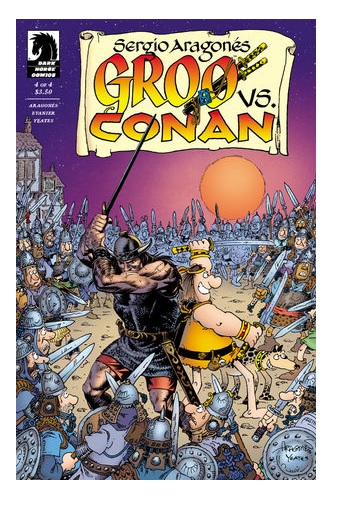
GROO VS CONAN #4
Writers: Sergio Aragones and Mark EvanierArtists: Sergio Aragones and Tom Yeates
Publisher: Dark Horse Comics
Reviewer: Masked Man
So the mighty fray between the greatest fantasy hero and the greatest fantasy hero parody comes to a close. And while the great Sergio Aragones and his partner in crime Mark Evanier threw a bunch of curveballs in this miniseries, telling four stories at the same time, it all ended up rather predictably--but that's not to say the ride wasn't fun.
Like any project Sergio Aragones is a part of, the artwork is always a highlight. He richly illustrates pages and panels with such massive attitude and action that even his dialogue pages are exciting to read. To a degree, Aragones is a victim of his own success, as we've all come to expect oodles of excitement on each one of his pages--like if we don't see Groo, and now Conan, cutting down armies of warriors, each one having their own personalities as they are dying, being killed, or about to be killed, we will become disappointed with him. Amazingly enough, Serigo Aragones has yet to drop the ball and his work here is as great as it always is. As for Conan himself and the scenes in Conan's World, Tom Yeates takes over the artistic role, which gives a nice aesthetic to the series, showing off the differences in purpose of each character, realism vs. parody (although I must say I was a bit disappointed that at no point did Aragones get to draw Conan or Yeates get to draw Groo--a back gallery or something). While Yeates does a fine job giving dramatic weight and realism to Conan, overall it was rather unimpressive. The fanboy in me wonders what this would have looked like if Marvel had the balls to do this years ago during Groo's original run at Marvel, and perhaps the late great John Buscema could have drawn Conan--'the' Groo artist with 'the' Conan artist, in comics at least. But no complaints: this miniseries still delivered.
As I mentioned at the start, the book does turn rather formulaic at the end. Prepare for spoilers! After a few false starts, the actual battle between Conan and Groo finally takes place in issue #4. Mind you, I could easily see Evanier (almost Grant Morrison-ish) claiming it's all a work of fiction, so each battle described in the miniseries is as real as the other. Either way, as the final battle nears its climax, it ends the way most comic book crossovers do: with no real winner and the characters basically teaming up at the end, although one could argue Groo is the victor, as Conan was the one tasked with killing Groo, and Groo, as usual, had no idea what was going on. Still, Conan fared better than most who challenge Groo's steel, deciding that he couldn't kill what he couldn't understand and that he best just stick to his side of reality. The other plotlines, of the comic book store and the bakery, pretty much play out as you might expect, though guessing the exact road to their mirror conclusion would prove most difficult. Even the story of Sergio and Mark themselves wraps up you would expect, with the drugs and the head trauma finally wearing off and the two ready to create the comic we just read, plus giving us a clue of what to expect next for Groo.
So even with the final conclusions in this miniseries being fairly predictable, it never took away from the fun of a typical Aragones and Evanier madcap adventure. It was a blast to see Conan just struggling to even comprehend Groo, while Groo, of course, had trouble just trying to figure out what the hell he should be doing at any given moment! One could easily argue the whole 'real world' angle of the story was unnecessary, and I'd agree, as it was an obvious device to keep the story from being too comic book crossover typical. It still didn't undermine the integrity of the story as a whole, and it allowed Aragones and Evanier to do their usual society mocking as well.
So on the Masked Man's scale of Crap, Poor, Decent, Good, and Great, GROO VS CONAN scores a GOOD.
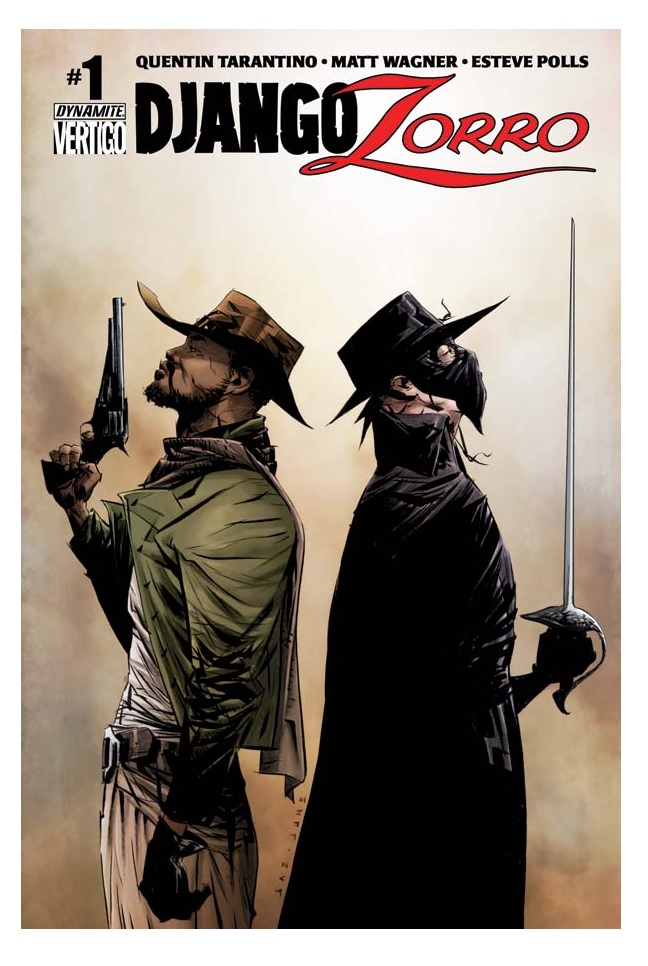
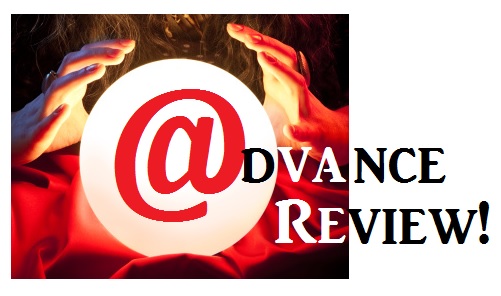 In stores today!!
In stores today!!DJANGO/ZORRO #1
Writers: Quentin Tarantino and Matt WagnerArtist: Esteve Polls
Publisher: Dynamite Entertainment/Vertigo
Reviewer: Corey Michael Dalton
As a fan of DJANGO UNCHAINED (and Quentin Tarantino films in general), I was excited to get my hands on an advance copy of DJANGO/ZORRO #1, billed as the official sequel to the movie. Because it spends most of its time introducing the characters and the plot, this first issue isn’t the most revolutionary comic ever, but it does set the stage for what promises to be an enjoyable team-up.
Set (I assume) some time after the bloody conclusion of DJANGO UNCHAINED, the debut issue of this six issue miniseries finds Django wandering the desert in Arizona when he encounters an ornate carriage. The occupant of the carriage, a rich man named Don Diego de la Vega, is surprisingly nondiscriminatory, offering Django a ride. When the carriage is stopped by bandits, Django hops out, kills the robbers, and reveals that he is actually a bounty hunter using Diego as bait to lure his targets into the open. Instead of being upset by this revelation, Diego hires Django to accompany him on a mission to Phoenix as a bodyguard. Later, at a stop for supplies in Yuma, Diego single-handedly bests four ruffians who are hassling him, displaying hidden fighting skills of his own. As Diego and Django leave for an encounter with the “Archduke of Arizona,” one of the ruffians discovers a “Z” carved into the palm of his hand.
Although the series is billed as being co-written by Tarantino, the dialogue doesn’t have his usual spark, which makes me wonder if he was involved mainly at a conceptual/plot level rather than actually putting fingers to keyboard. Oh, the dialogue isn’t bad, per se--just rather conventional. There are some nice moments, though. Early on, for example, Django admits that Diego—a Spanish-speaking, well-mannered, older gentleman—reminds him of Dr. King Schultz—the German-speaking, well-mannered, older gentleman who bought his freedom in DJANGO UNCHAINED. It’s a shorthand way to create a bond between the two, and it works (unfortunately, the moment is repeated later in the issue, which seems superfluous.) Setting up Zorro as a mentor for the younger Django is an excellent spine for the story; Django is looking for a replacement for his friend King Schultz while Zorro (no spring chicken in this story) is looking for someone to take on his mantle and fight evil. Another thing that works in the issue is that both Django and Zorro get a chance to shine in their individual action set pieces. Both these guys are badasses.
Not everything worked, though. The end of the issue is a weak spot, for example. Why end the issue revealing a “Z” carved into one of the ruffians’ hands, as if the reader is supposed to be surprised that Don Diego is Zorro? The issue is called DJANGO/ZORRO, after all, so we know Zorro is in it. And even I, a relative neophyte to the Zorro mythos, knows that Diego is Zorro. Speaking of my unfamiliarity with Zorro, was Diego always so much of a wuss? I mean, I know he was a rich playboy type, but I don’t recall him being an effeminate dandy wearing matching purple sashes around his waist and neck, carrying a lemon yellow parasol, and riding in what Django calls a “Cinderella coach.” I also didn’t care for the occasional narration. First off, I didn’t figure out who was narrating until several pages in. At first, I assumed it was Diego speaking, but when the narrator described Diego as his “milk brother” I realized that the narrator must have been Diego’s driver, Bernardo. I thought the driver was an incidental character, but later discovered (via the Internet) that Bernardo is Zorro’s mute sidekick. I wish that had been explained in the issue itself—if not in the story, then maybe in a text piece on the inside front cover or something. Either way, I found the narration ponderous and a little distracting. Lines like “It is often said that a wild animal can smell its own kind. So it was when Diego first met the rogue known only as Django.” really add nothing to the story and remind me of the worst excesses of Chris Claremont.
The art is uniformly good throughout. Of course the Jae Lee cover is fantastic—but I’m an easy mark for Jae Lee. The interior art is a bit scratchy for my taste, with lots of hashing on the characters’ faces, but it works for this sort of a story. The extra lines make the characters and their environment seem rough and unkempt--appropriate for the Old West. One minor nitpick: I didn’t realize that Bernardo was meant to be Native American until it became a plot point. I guess the ponytail should have tipped me off? I’m not really sure how the artist could have conveyed that any better, though, so perhaps there could have been a reference in the dialogue ahead of time.
Overall, I can’t say that DJANGO/ZORRO #1 set my world on fire, but it was good enough to make me want more—mainly on the strength of the concept and the promise of what’s to come. I am still intrigued by the idea of these two characters teaming up, and want to see them get beyond the “getting to know you” stage and into some real adventure. If Django puts on Zorro’s mask later in the series, I will be quite pleased.
Corey Michael Dalton has written and/or edited trade books, magazine articles, short stories, novels, comics, plays, radio shows, reviews, websites, blogs, and more. You name it, he's probably written it. Except religious scriptures. He hasn't gotten around to those just yet. Soon ...
Proofs, co-edits & common sense provided by Sleazy G
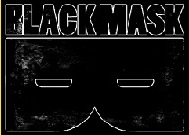 The next level of comic book excellence is a click away at BLACK MASK STUDIOS!
The next level of comic book excellence is a click away at BLACK MASK STUDIOS! Want more in all things Geek?
Want more in all things Geek?Check out our friends at PoptardsGo for podcasts, reviews, and more!
 And if you still need more geek in your life, check out Part-Time Fanboy for more geeky goodness on comics, movies, and more!
And if you still need more geek in your life, check out Part-Time Fanboy for more geeky goodness on comics, movies, and more!Finally, check out AICN COMICS on Facebook and Comixpedia!
